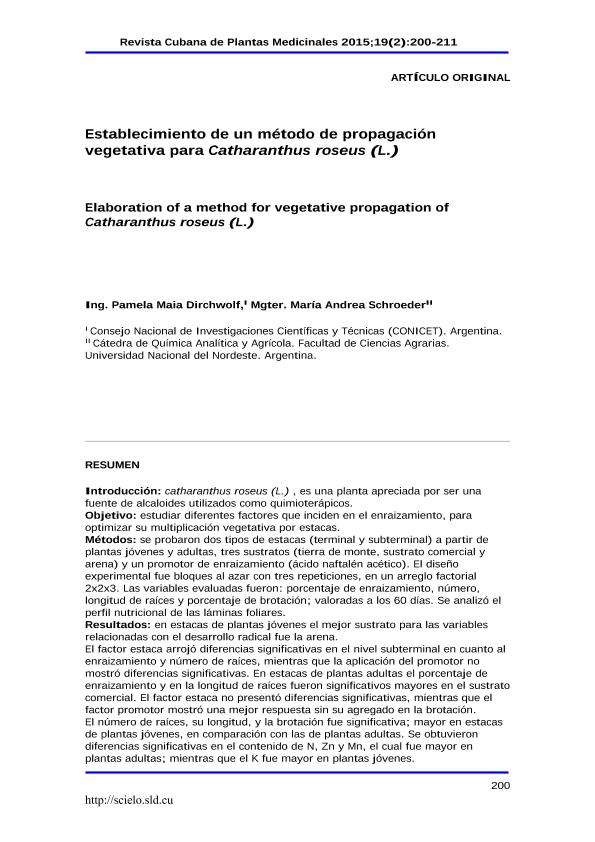Artículo
Introducción: catharanthus roseus (L.) , es una planta apreciada por ser una fuente de alcaloides utilizados como quimioterápicos. Objetivo: estudiar diferentes factores que inciden en el enraizamiento, para optimizar su multiplicación vegetativa por estacas. Métodos: se probaron dos tipos de estacas (terminal y subterminal) a partir de plantas jóvenes y adultas, tres sustratos (tierra de monte, sustrato comercial y arena) y un promotor de enraizamiento (ácido naftalén acético). El diseño experimental fue bloques al azar con tres repeticiones, en un arreglo factorial 2x2x3. Las variables evaluadas fueron: porcentaje de enraizamiento, número, longitud de raíces y porcentaje de brotación; valoradas a los 60 días. Se analizó el perfil nutricional de las láminas foliares. Resultados: en estacas de plantas jóvenes el mejor sustrato para las variables relacionadas con el desarrollo radical fue la arena. El factor estaca arrojó diferencias significativas en el nivel subterminal en cuanto al enraizamiento y número de raíces, mientras que la aplicación del promotor no mostró diferencias significativas. En estacas de plantas adultas el porcentaje de enraizamiento y en la longitud de raíces fueron significativos mayores en el sustrato comercial. El factor estaca no presentó diferencias significativas, mientras que el factor promotor mostró una mejor respuesta sin su agregado en la brotación. El número de raíces, su longitud, y la brotación fue significativa; mayor en estacas de plantas jóvenes, en comparación con las de plantas adultas. Se obtuvieron diferencias significativas en el contenido de N, Zn y Mn, el cual fue mayor en plantas adultas; mientras que el K fue mayor en plantas jóvenes. Conclusiones: la propagación vegetativa mediante estacas de C. roseus fue posible, y permitió obtener en forma rápida y simple, plantas de porte homogéneo. La multiplicación fue favorecida al utilizar estacas provenientes de plantas jóvenes, subterminales, en arena, sin Ácido 1-naftalén-acético. Introduction: catharanthus roseus var. roseus (L.), is a prized plant because it has several antitumor alkaloids. Objective: to evaluate the effect of indoleacetic acid, cutting types, plant age and substrates on Catharanthus roseus (L.) rooting. Methods: the experiment was arranged in a complete randomized design with a 2 x 2 x 3 factorial with three replications, with two ANA concentrations (0 and 1000 ppm), two positions in the stem (terminal and subterminal) and three types of substrate (commercial substrate, local low fertility soil and sand) in plants aged less and more than a year. After 60 days, percentage of rooted cuttings, root number and length, and percentage of sprouting were evaluated. A nutritional analysis of leaf blades was performed. Results: the best scores in terms of rooting rates were obtained for the sand, the subterminal portion of the branch and without the rooting promoting substance, in younger plants. Older cuttings best development was found in commercial substrate. No statistical differences were found between cutting types or with or without the rooting promoting substance. Root length and number, as well as sprouting were significantly better using younger cuttings. Nitrogen, Zinc and Manganese content were significantly superior in older plants, but Potassium was higher in the younger ones. Conclusion: the results obtained demonstrate that the potential of C. roseus to be propagated by cuttings is possible, and that is even better if subterminal young cuttings, in sand, without rooting promoters are used.
Establecimiento de un método de propagación vegetativa para Catharanthus roseus (L.)
Título:
Elaboration of a method for vegetative propagation of Catharanthus roseus (L.)
Fecha de publicación:
04/2015
Editorial:
Editorial Ciencias Médicas
Revista:
Revista Cubana de Plantas Medicinales
ISSN:
1028-4796
Idioma:
Español
Tipo de recurso:
Artículo publicado
Clasificación temática:
Resumen
Archivos asociados
Licencia
Identificadores
Colecciones
Articulos(CCT - NORDESTE)
Articulos de CTRO.CIENTIFICO TECNOL.CONICET - NORDESTE
Articulos de CTRO.CIENTIFICO TECNOL.CONICET - NORDESTE
Citación
Dirchwolf, Pamela Maia; Schroeder, María Andrea; Establecimiento de un método de propagación vegetativa para Catharanthus roseus (L.); Editorial Ciencias Médicas; Revista Cubana de Plantas Medicinales; 20; 2; 4-2015; 200-211
Compartir




